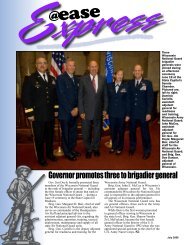At Ease - Wisconsin National Guard Department of Military Affairs
At Ease - Wisconsin National Guard Department of Military Affairs
At Ease - Wisconsin National Guard Department of Military Affairs
Create successful ePaper yourself
Turn your PDF publications into a flip-book with our unique Google optimized e-Paper software.
neW equipment influx<br />
By Robert Giblin<br />
<strong>At</strong> <strong>Ease</strong> Staff<br />
<strong>Wisconsin</strong> is among the first states to receive what’s<br />
described as a “tidal wave” by <strong>of</strong>ficials at the national<br />
level. Here in the Badger State, it seems more like a<br />
Great Lakes seiche — a large, persistent swell sustained<br />
by the prevailing climate.<br />
“It’s bigger than I ever imagined, and it has been<br />
a long time coming,” said Chief Warrant Officer Philip<br />
Kilbane, <strong>Wisconsin</strong>’s force integration readiness <strong>of</strong>ficer.<br />
Like a gathering seiche, the influx <strong>of</strong> new gear to<br />
<strong>Wisconsin</strong> units, which has already started, is causing<br />
some ripples — challenges that <strong>Wisconsin</strong> <strong>Guard</strong><br />
units and their Soldiers are<br />
delighted to have.<br />
The influx not only<br />
will bring equipment that<br />
<strong>Wisconsin</strong> <strong>Guard</strong> units<br />
never had, but some units<br />
may see new structure,<br />
facilities and skill sets. For<br />
example, <strong>Wisconsin</strong>’s military<br />
intelligence unit — Company B, Brigade Special Troops<br />
Battalion — is slated to receive the Shadow, a powerlaunched<br />
unmanned aircraft system. The Shadow<br />
requires special storage facilities, and its Soldiers will<br />
have to be able to transport the aircraft to Fort McCoy<br />
or other areas with the restricted airspaces where it can<br />
be flown. To operate the system, the unit will have to fill<br />
slots and train Soldiers in a new military occupational<br />
specialty.<br />
The 32nd Infantry Brigade Combat Team already<br />
has received a lot <strong>of</strong> new equipment, ranging from<br />
new weapons to the Raven, a smaller, hand-launched<br />
unmanned aircraft, which was issued to the infantry<br />
battalions.<br />
The long list <strong>of</strong> additional new equipment <strong>Wisconsin</strong><br />
Army <strong>National</strong> <strong>Guard</strong> units are receiving includes:<br />
• Small arms, from the 9 mm pistol to the M-2<br />
machine gun, and everything in between.<br />
• Warfighters Information Network-Tactical (WIN-T)<br />
communications system, and the Secure Mobile<br />
Anti-Jam Reliable Tactical Terminal (SMART-T).<br />
• Personnel Services Delivery Redesign (PSDR)<br />
DTTS is something the <strong>Guard</strong> hasn’t had before, Fortune<br />
said. So units that receive it will start from scratch recruiting<br />
and training crews.<br />
WIN-T, the new high-speed, high-capacity digital<br />
communications network, requires a shorter training period —<br />
13 weeks — but many more troops must be trained to use it,<br />
Fortune said.<br />
Training is just one task <strong>Guard</strong> units must tackle. Some<br />
new equipment will require new facilities — new hangars,<br />
maintenance bays and storage areas.<br />
Shadow UAVs, for example, have “storage issues.” They<br />
require “unique facilities,” Jones said. They will also require<br />
“From a new equipment standpoint,<br />
we’re going to be very, very busy<br />
for the next few years.”<br />
•<br />
•<br />
•<br />
•<br />
system to manage personnel issues at the unit<br />
level.<br />
UH-60M utility helicopters and UH-60A medical<br />
evacuation helicopters. (See related story on<br />
page 70.)<br />
Numerous battlefield communications systems.<br />
New vehicles, including various configurations <strong>of</strong><br />
up-armored Humvees.<br />
High Mobility Artillery Rocket System (HIMARS),<br />
which replaces the Multiple Launch Rocket<br />
System (MLRS).<br />
Kilbane said the new equipment should add some<br />
excitement at all levels, including the motor pool and<br />
maintenance. “Think back to the days when we used<br />
to have the Number One<br />
Common Tool Set in the<br />
motor pool. Soldiers would<br />
have to fabricate something<br />
to haul it and load it on<br />
trucks,” he said.<br />
“Now, they’re going<br />
to have the Standard<br />
Automatic Tool Set with a<br />
trailer-mounted CONEX container. It’s complete, and not<br />
just home-made.” CONEX containers are large, steel<br />
shipping containers that can be loaded and sealed on<br />
ships, trucks, airplanes and railroad cars.<br />
<strong>Wisconsin</strong> also is receiving the Forward Repair<br />
System, a flat-rack system with a crane, generator,<br />
CONEX, welder, compressor and other tools designed to<br />
be hauled on the back <strong>of</strong> a palletized load system. “It’s<br />
like a maintenance shop that can be dropped into place<br />
in the field. They can open the doors, complete repairs<br />
and pick it up and move it,” said Kilbane.<br />
The new Set Equipment Contact Maintenance<br />
(SECM) system is mounted on an up-armored Humvee.<br />
While some new equipment is already in place,<br />
other equipment will arrive over the next several years,<br />
said Kilbane. “Several factors will have an impact on<br />
how quickly new equipment arrives, but in general,<br />
the timeline is: first to deploy; next to deploy; and<br />
everyone else. There are still going to be some units with<br />
equipment shortages in the short term, but their turn is<br />
coming. From a new equipment standpoint, we’re going<br />
to be very, very busy for the next few years.”<br />
~ Chief Warrant Officer Philip Kilbane<br />
restricted airspace for flying.<br />
New trucks and armored vehicles won’t fit in some <strong>of</strong> the<br />
<strong>Guard</strong>’s current maintenance facilities. Some new battlefield<br />
systems will require greater security than is provided for<br />
existing <strong>Guard</strong> gear. And some new acquisitions, such as<br />
chemical and biological warfare gear, will require environmental<br />
impact assessments.<br />
The Equipping Working Group’s job is to anticipate these<br />
hurdles and help <strong>Guard</strong> <strong>of</strong>ficials in the states overcome them. In<br />
the coming year, the working group will urge <strong>Guard</strong> leaders in<br />
the states to begin developing detailed equipment fielding plans<br />
that run through 2015.<br />
March 2009 45





